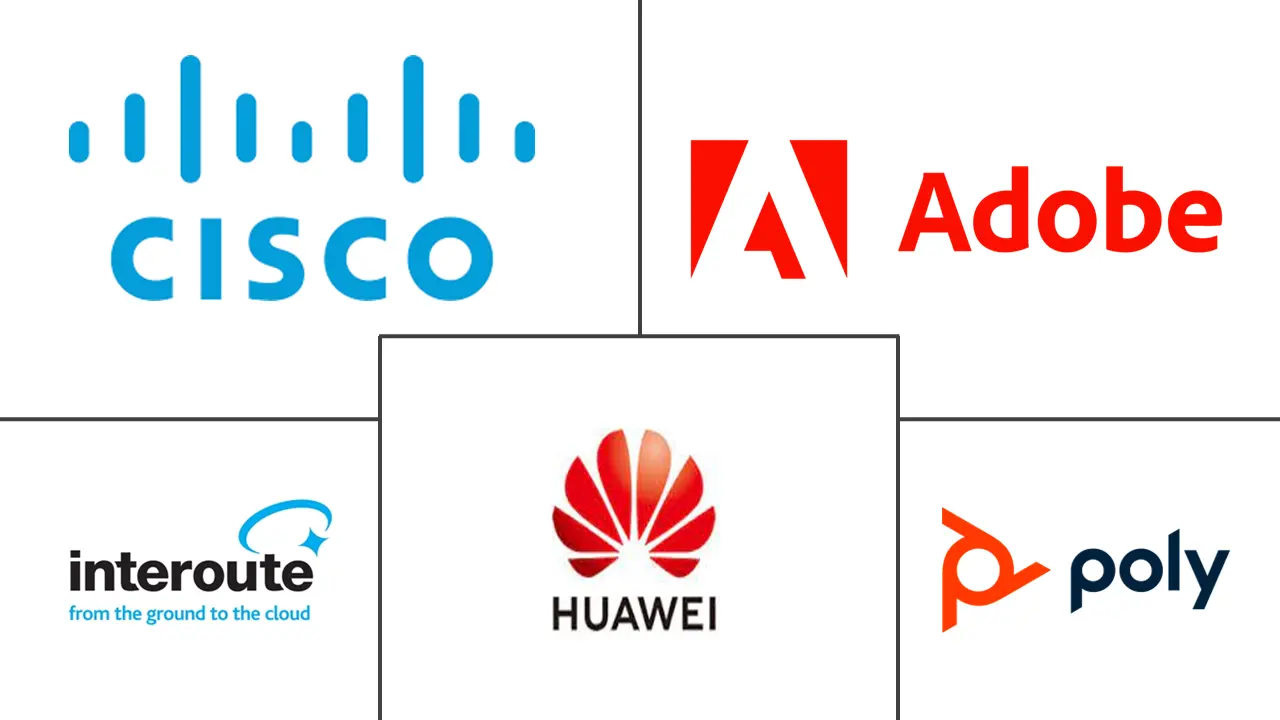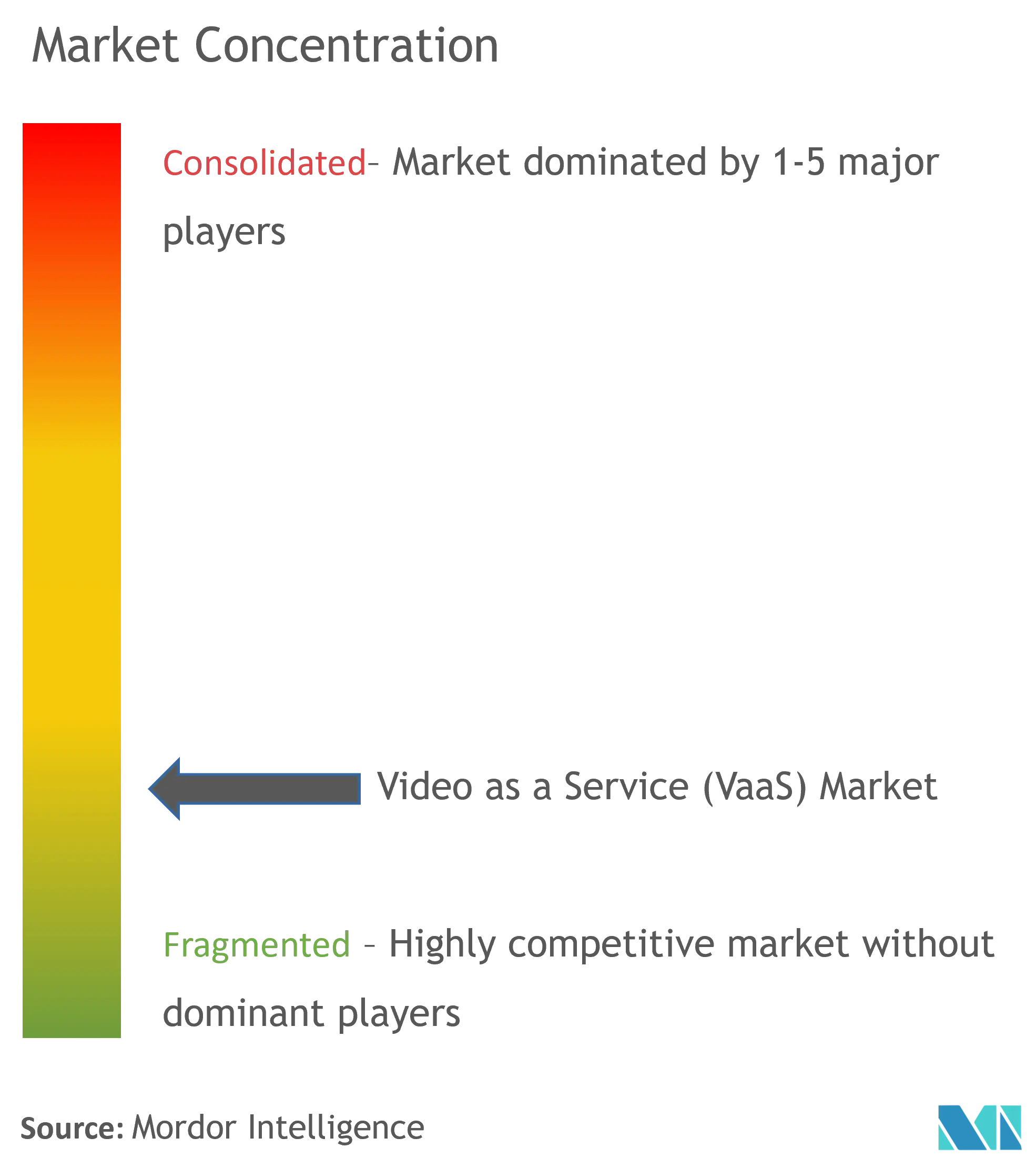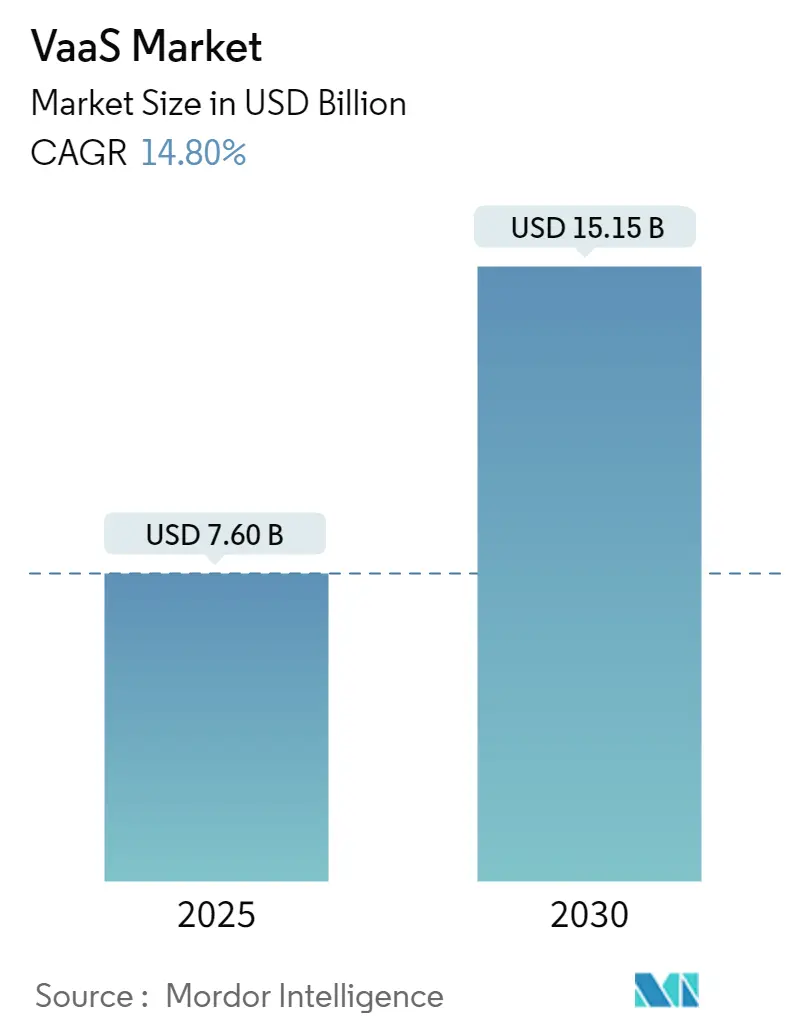
Video as a Service Market Analysis
The VaaS Market size is estimated at USD 7.60 billion in 2025, and is expected to reach USD 15.15 billion by 2030, at a CAGR of 14.8% during the forecast period (2025-2030).
Video as a Service (VaaS) is a cloud-based video communication service that allows users to conduct video conferences, video calls, and live video streaming over the Internet. VaaS providers offer the necessary infrastructure, software, and tools to enable businesses and individuals to communicate through video.
- Due to the high scalability, flexibility, and affordability provided by the cloud architecture, there is a discernible movement in demand away from on-premises video conferencing (VC) and collaboration solutions to cloud-based solutions. The popularity of cloud-based solutions has accelerated the demand for video as a service (VaaS). It saves time and travel expenses, as participants can collaborate from anywhere with an Internet connection. It also provides meeting transcription services, which can assist with product presentations, financial reviews, and other types of meetings.
- VaaS enhances productivity and efficiency, as participants can easily share and collaborate on documents and presentations in real time. Several video conferencing solutions vendors have implemented various business models to better serve their clients. Solution providers are putting their efforts into providing solutions specifically tailored to satisfy the needs of multiple enterprises.
- The use of cloud-based solutions is also increasing, as are the expenditures made to add new capabilities like immersive telepresence, voice and face recognition, HD audio and video, and artificial intelligence (AI). There will likely be more competition among the market players due to advancements in technology, innovations, and the entry of new VaaS solution providers, which would facilitate small and medium businesses to utilize affordable hybrid cloud-based collaboration and VC solutions.
- Further, VaaS can have various uses in the healthcare sector, such as remote healthcare services, telemedicine, video consultations, medical education, etc. With video conferencing, physicians and medical staff can interact with patients in real time, regardless of their physical location, which can be beneficial for patients who may have difficulty traveling. Additionally, medical staff can receive remote training and collaborate with other professionals in real time using video conferencing, which can improve the quality of care provided to patients.
- The market players are strategically deploying advanced VaaS to expand their presence and capture the market share. For instance, in October 2022, Pexip, an international provider of video technology, launched Pexip's Video Platform as a Service. With the service, the company hopes to empower big businesses to create innovative new products, incorporate video into workflows, and innovate. (VPaaS). Pexip's organizational structure, which currently comprises a new business unit with dedicated technical and commercial resources throughout the Americas, EMEA, and APAC, supports the company's focus on video innovation. Customer and citizen engagement, healthcare, and video-enabled extended reality are claimed to be the three major growth areas that this team is focusing on.
- Additionally, there are several uses of video as a service in the defense sector. Video surveillance is one such use, where cameras are used for security purposes. Additionally, video conferencing can be used by the government and defense sector for communication and collaboration. The defense sector can also use cloud services to store and access mission-critical data. Furthermore, innovative digital applications and services can be leveraged by the military and defense communication industry. The defense sector is influenced by various macroeconomic trends such as government spending, economic growth, and global economic conditions.
- On the other side, high acquisition and integration costs and data security and privacy concerns restrain the growth of the studied market. Several false alarms are triggered as a result of malfunctioning equipment and unfavorable weather or environmental conditions. Data security and privacy issues are anticipated to be a roadblock due to the service’s poor integration or lack of system synchronization.
Video as a Service Market Trends
The Hybrid Cloud Segment is Anticipated to Drive the Market Demand
- The hybrid cloud has seen significant overall growth in recent years compared to other cloud services, as it provides several benefits to organizations with large data volumes. Companies can scale computing resources by using a hybrid cloud. It also reduces the need to invest large sums of money to handle short-term surges in demand, which is useful when the company has to free up local resources for sensitive data or applications. Companies that use cloud services must pay only for the resources they use momentarily rather than purchasing, programming, and maintaining extra resources and equipment that sit dormant for long periods. This assists businesses in reducing costs that do not generate revenue.
- When processing and computing demand fluctuates, hybrid cloud computing enables businesses to scale out their on-premises infrastructure to the public cloud to address any overflow without exposing all of their data to third-party data centers. These innovations have proved beneficial in addressing the worries of end-users who were previously unwilling to migrate to this solution due to concerns about data security. Organizations benefit from the public cloud's flexibility and computing capacity for basic and non-sensitive computing tasks while keeping business-critical programs and data on-premises and secure behind a company firewall. To develop a hybrid cloud, service providers strive to create a combination of on-premise private cloud and public cloud that share a network connection.
- Further, a hybrid cloud is cost-effective when the user wishes to use both private and public cloud solutions or services on a single platform. In addition, the hybrid cloud allows an easy transition to the multi-cloud and does not require the customers to invest in an additional hardware component. Unlike private and public clouds, in the hybrid cloud, all the control is given to the organization and is not managed by a third party or the provider. Therefore, government organizations and banking sectors need not worry about the security of sensitive assets or workloads.
- The investment in this space has also grown exponentially over the past few years, as security is becoming one of the significant challenges for the growth of the technology. Companies offering hybrid cloud solutions are focusing heavily on security. Solution providers are offering integrated security services to cater to the consumer's requirements by providing multilayer security and monitoring. For example, McAfee, HP, and Cisco are working towards the development of high-level security systems to protect the data stored on hybrid clouds. With the market size growing significantly and companies expanding their hybrid cloud capabilities, the focus on security is increasing. Users rely on third-party hybrid cloud security solution providers to improve their abilities further.
- According to Service Express, an average of 48% of surveyed organizations' IT infrastructure environments were on-premises data centers, according to a 2022 poll in the United States. The public cloud accounted for 18%, while colocation and hosted private cloud both accounted for 17%. Such massive usage of the cloud would push the market players to deploy their solutions to the cloud.
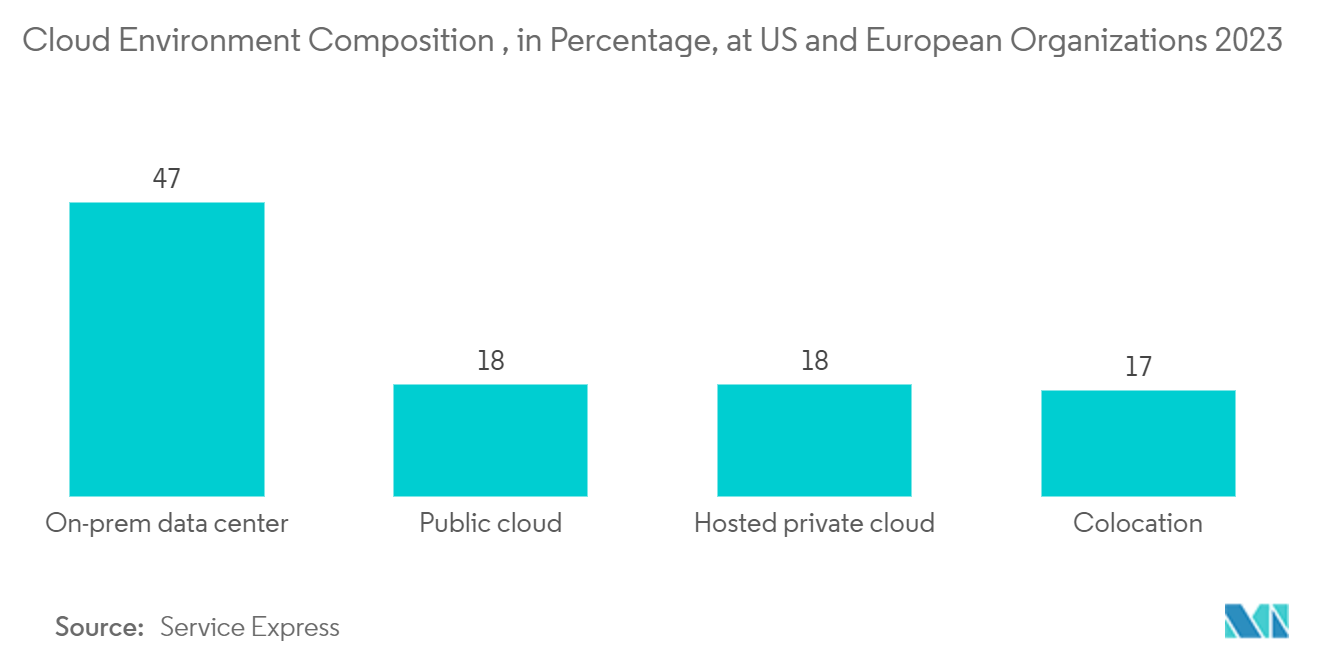
North America is Anticipated to Hold the Largest Market Share
- The United States is the largest economy in the world and has been a significant market for Video as a Service in the North America region. The flexibility, comfort, content personalization, availability of diverse content, and content volume have primarily driven the adoption of Video as a Service. With smartphone transmission speeds increasing dramatically, the country is witnessing an early transition from 4G to 5G.
- With increased rates of 5G, higher-resolution videos are expected to witness an uptick in demand. It is expected that 5G will enable faster and more reliable video streaming, as well as new video services such as HD video and XR services. Moreover, the introduction of 5G is anticipated to affect video surveillance for businesses and the video streaming industry, leading to rapid growth in the connected ecosystem. 5G would have a significant impact on the Video as a Service market, allowing for new and improved services and experiences for consumers.
- Further, Zoom, Microsoft Teams, and Google Workspace have all seen a spike in demand for video software and services as a result of the abrupt shift of many firms to a work-from-home culture. The number of individuals who are actively using these sites is significantly increasing. Microsoft Teams reported 270 million monthly active users in January 2022, an increase of 20 million from July 2021.
- Major industry players in the region are constantly enhancing their product offerings to maintain a competitive edge and suit the evolving needs of end customers. Therefore, they combine VaaS with advanced technologies like AI, deep learning, and machine learning. Additionally, VaaS market players embrace advanced AI-based VaaS to offer a self-contained way to monitor and enhance video content services in real time.
- For instance, the American company Zoom Video Communications, Inc., which develops communications technology, recently announced the addition of end-to-end encryption capabilities to its already-available video-as-a-service offerings for free and premium users worldwide. Additionally, integrating these sophisticated technologies into VaaS can lead to significant improvements in accuracy and a decrease in false alarms. These factors are anticipated to present new chances for the industry in the coming years.
- In March 2023, Amazon Interactive Video Service (Amazon IVS), a managed live streaming solution enabling developers to create interactive video experiences, was introduced by Amazon Web Services (AWS). Currently, developers create apps for various industries, such as social networking, e-commerce, and fitness, using Amazon IVS. Since the introduction of the Amazon IVS, collaborative live streaming has been a significant trend. Companies like Twitch have introduced tools like Guest Star that let streamers draw viewers into live video shows, resulting in more exciting and interactive programming.
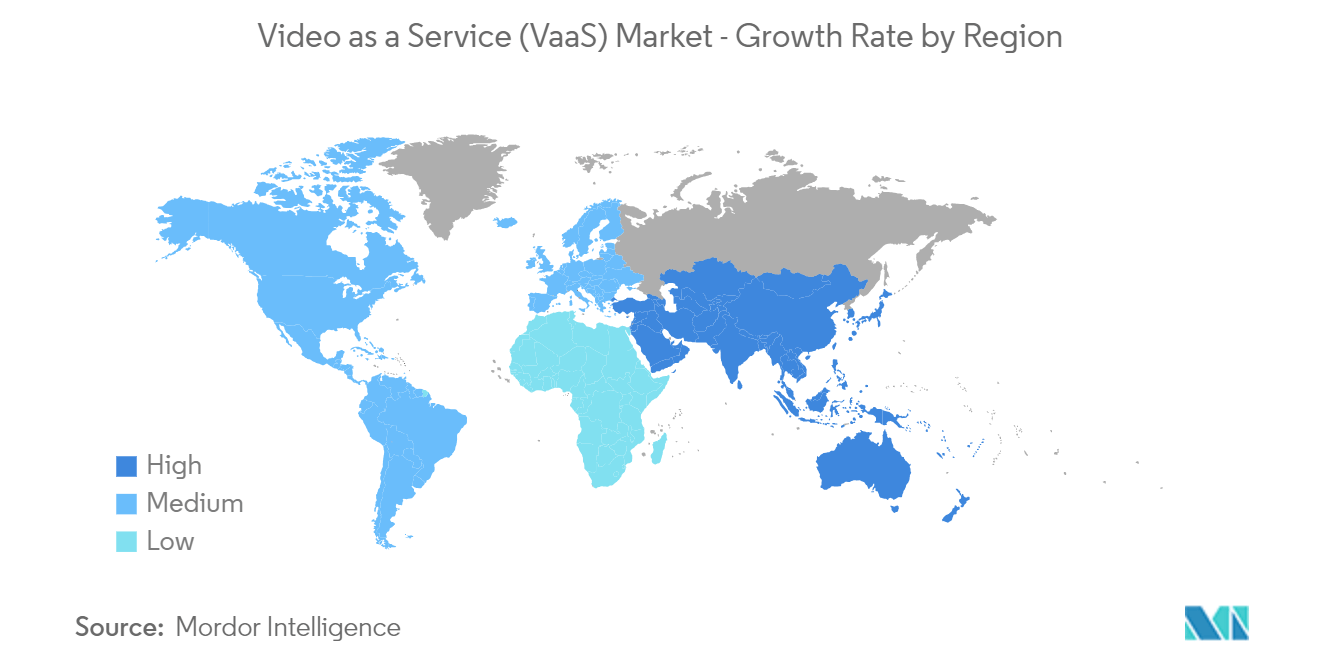
Video as a Service Industry Overview
The video as a service market is fragmented as the global players are innovating their services to provide cost-benefit offers to the users, which gives a high rivalry to the market competitors. Key players are Cisco Systems, Inc., Huawei Technologies Co., Adobe Systems, Polycom, Inc., etc. Recent developments in the market are -
- July 2022 - New Calling, a brand-new calling solution, was jointly launched by Zhejiang Mobile, Jingyou Technology, and Huawei. To redefine current call services and offer great audio and video call quality to individual users as well as business customers, this solution uses the "1 platform + 3 capabilities + N services" architectural model. The New Calling system allows three competitive calling capabilities—UHD video calling, intelligent video calling, and interactive video calling—by creating the New Calling Platform and Unified Media Function on top of the core voice network.
- March 2022 - ZTE Corporation, a significant global supplier of telecommunications, enterprise, and customer technology solutions for the mobile internet, announced the debut of its Premium Video Platform 2.0 (PVP2.0) big video solution. The PVP2.0 solution for "New Ecosystem" can offer an operator-centric ATV launcher, allowing operators to adopt their preferred service display styles as necessary. Operators can rapidly and efficiently incorporate third-party features and apps like Google Assistant and Google Ads. With the support of a converged video platform, it enables operators to expand their service into more new markets, creating opportunities for business partnerships.
Video as a Service Market Leaders
-
Cisco Systems, Inc.
-
Huawei Technologies Co., Limited
-
Adobe Systems
-
Interoute Communications Limited
-
Polycom, Inc.
- *Disclaimer: Major Players sorted in no particular order
Video as a Service Market News
- April 2024: Axis Communications has launched Axis Cloud Connect. This new service facilitates seamless integration between Axis devices and partner applications, providing a suite of managed services. These managed services not only ensure secure remote access to live video operations but also enhance device management through automated updates over the device's lifecycle.
- January 2024: Jabra has unveiled Jabra+ for Admins, a cloud-centric, API-first software platform designed for the remote oversight and management of meeting rooms and devices. This innovative platform sets the stage for enhanced experiences tailored to IT administrators, end users, and partners. The journey begins with the management of meeting rooms and video devices, available to customers through an Early Adopter Program.
Video as a Service Industry Segmentation
The video as a service market is a fully managed visual communication solution complete with high capacity, low latency connectivity. Majorly, managed services in small and medium businesses include video conferencing and video communication, which are used mostly in organizations to run day-to-day business models.
The video as a service market is segmented by platform (application management, device management, and network management), device (mobility devices and enterprise computing), service (managed and professional), by deployment model (public cloud, private cloud, and hybrid cloud), end-user industry (government and defense, BFSI, healthcare, it & telecom, media & entertainment, manufacturing, and other end-user industries), and geography ( North America, Europe, Asia-Pacific, Latin America and Middle East, and Africa). The market sizes and forecasts are provided in terms of value (USD) for all the above segments.
| By Platform | Application Management |
| Device Management | |
| Network Management | |
| By Device | Mobility Devices |
| Enterprise Computing | |
| By Service | Managed |
| Professional | |
| By Deployment Model | Public Cloud |
| Private Cloud | |
| Hybrid Cloud | |
| By End-user Industry | Government and Defense |
| BFSI | |
| Healthcare | |
| IT & Telecom | |
| Media & Entertainment | |
| Manufacturing | |
| Other End-user Industries | |
| Geography*** | North America |
| Europe | |
| Asia | |
| Latin America | |
| Middle East and Africa |
Video as a Service Market Research FAQs
How big is the VaaS Market?
The VaaS Market size is expected to reach USD 7.60 billion in 2025 and grow at a CAGR of 14.80% to reach USD 15.15 billion by 2030.
What is the current VaaS Market size?
In 2025, the VaaS Market size is expected to reach USD 7.60 billion.
Who are the key players in VaaS Market?
Cisco Systems, Inc., Huawei Technologies Co., Limited, Adobe Systems, Interoute Communications Limited and Polycom, Inc. are the major companies operating in the VaaS Market.
Which is the fastest growing region in VaaS Market?
Asia Pacific is estimated to grow at the highest CAGR over the forecast period (2025-2030).
Which region has the biggest share in VaaS Market?
In 2025, the North America accounts for the largest market share in VaaS Market.
What years does this VaaS Market cover, and what was the market size in 2024?
In 2024, the VaaS Market size was estimated at USD 6.48 billion. The report covers the VaaS Market historical market size for years: 2019, 2020, 2021, 2022, 2023 and 2024. The report also forecasts the VaaS Market size for years: 2025, 2026, 2027, 2028, 2029 and 2030.
Our Best Selling Reports
Residential Real Estate in China Industry Report
Statistics for the 2025 VaaS market share, size and revenue growth rate, created by Mordor Intelligence™ Industry Reports. VaaS analysis includes a market forecast outlook for 2025 to 2030 and historical overview. Get a sample of this industry analysis as a free report PDF download.

